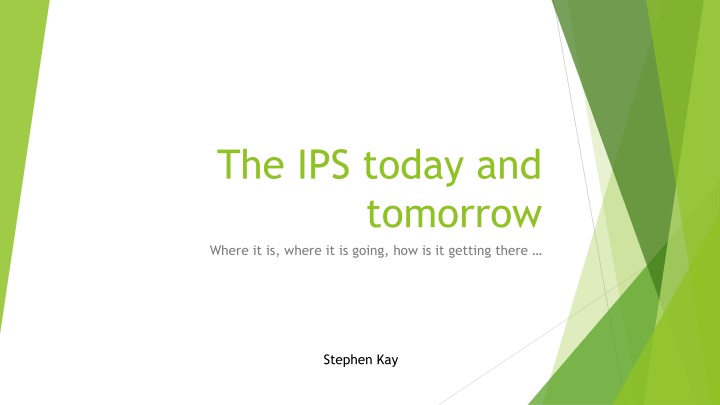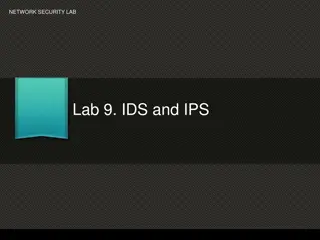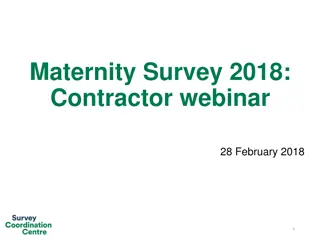International Patient Summary: Today and Tomorrow - Achievements and Challenges in Healthcare Interoperability
The International Patient Summary (IPS) has made significant strides, gaining recognition and evolving from a regional standard to an international one. The transition has brought about both advantages and challenges, with a growing awareness of IPS's potential in healthcare. The move towards the 2nd edition involves addressing emergent requirements and ensuring governance, integrity, and resilience in managing data changes. Additional Artefacts like ISO 27269 HL7 FHIR Implementation Guides are being developed to support IPS's central role in a vibrant healthcare ecosystem.
Download Presentation

Please find below an Image/Link to download the presentation.
The content on the website is provided AS IS for your information and personal use only. It may not be sold, licensed, or shared on other websites without obtaining consent from the author.If you encounter any issues during the download, it is possible that the publisher has removed the file from their server.
You are allowed to download the files provided on this website for personal or commercial use, subject to the condition that they are used lawfully. All files are the property of their respective owners.
The content on the website is provided AS IS for your information and personal use only. It may not be sold, licensed, or shared on other websites without obtaining consent from the author.
E N D
Presentation Transcript
The IPS today and tomorrow Where it is, where it is going, how is it getting there Stephen Kay
EN ISO 27269: 2021 The international 1st edition of IPS Advantages EN 17269:2019 became socialised By that, we mean that more people are aware of IPS and its potential significance for care, and for interoperability EN ISO 27269:2021 from CEN to ISO A wider set of requirements, and the reach to a wider audience as a direct result of the fast- track process of a regional standard to an international one, e.g., G7, GDHP, WHO, and +++ Plus the SDO s and their X-SDO activity & JIC New Artefacts: ISO 27269 HL7 FHIR Implementation Guide(s) HL7 CDA Implementation Guide IHE IPS Profile SNOMED IPS Free Set and IPS Terminology Easy to understand, simple to explain, but only now raises complex issues that have yet to be addressed by Digital Health, policy-makers and consideration of new use cases
EN ISO 27269: 2021 The international 1st edition of IPS Challenges The 1st edition of is 4 years old (Where we are) the fast-track process meant that substantive change requests were deferred to the next edition. The new ISO AHG activity that looks at the process side, amongst other things. It has changed the time from 18 months to 24 months to address the 2nd edition. New and emergent requirements, clinical and technical, as the eHN guidelines predicted that such changes would require the dataset to be extensible ! Governance, integrity, and resilience (Where it is going) It is not just the dataset that is required to manage change. There are a number of important, complementary initiatives that are committed to the IPS vision of a single solution. The IPS standard needs to stand-up to its central place in a vibrant ecosystem. It is The definitive framework of IPS data for use and reuse for healthcare Who provides the Maintenance Agency/ trusted authority for subsequent editions.
EN ISO 27269: 2021 The international 1st edition of IPS Advantages Challenges EN 17269:2019 became socialised The 1st edition of is 4 years old (Where we are) By that, we mean that more people are aware of IPS and its potential significance for care, and for interoperability the fast-track process meant that substantive change requests were deferred to the next edition. EN ISO 27269:2021 from CEN to ISO The new ISO AHG activity that looks at the process side, amongst other things. It has changed the time from 18 months to 24 months to address the 2nd edition. A wider set of requirements, and the reach to a wider audience as a direct result of the fast-track process of a regional standard to an international one, e.g., G7, DGHP, WHO, and +++ New and emergent requirements, clinical and technical, as the eHN guidelines predicted that such changes would require the dataset to be extensible ! Plus the SDO s and their X-SDO activity & JIC Governance, integrity, and resilience (Where it is going) New Artefacts: The advantages lead to further challenges. ISO 27269 HL7 FHIR Implementation Guide(s) It is not just the dataset that is required to manage change. There are a number of important, complementary initiatives that are committed to the IPS vision of a single solution. HL7 CDA Implementation Guide IHE IPS Profile The IPS standard needs to stand-up to its central place in a vibrant ecosystem. SNOMED Ref set The definitive framework of IPS data blocks for reuse Easy to understand, simple to explain, but only now raises complex issues that have yet to be addressed by Digital Health, policy-makers and consideration of new use cases Who provides the Maintenance Agency/ trusted authority for subsequent editions.
Europe (& the UK;) where are they? The new artefacts do not mention CEN or CEN TC 251 explicitly. A well-meaning comment from the X-SDO team said we need to bring CEN in .. I replied that we never left! But history is often a casualty in such circumstances . But only if we let it! Do not forget that we supplied the original requirements, courtesy of eHN, and subsequent requirements that have enriched the standard. We have a considerable investment in eHDSI and CDA experience, and whilst FHIR is very popular we can not forget the large community that are receptive to the IPS inputs from X-eHealth etc and JIC A principle of 17269/27269 is that IPS will remain implementation-independent. Implementation guidance for Europe (TS 17288) will be critical as a source of new requirements, and CEN TC251 must be there and be seen to be there. IPS is still a work in progress, but it is getting there! One more thing to consider
A summary is almost always an extract, however an extract is not always a summary
Thank you Stephen Kay IPS Co-lead with Rob Hausam






















